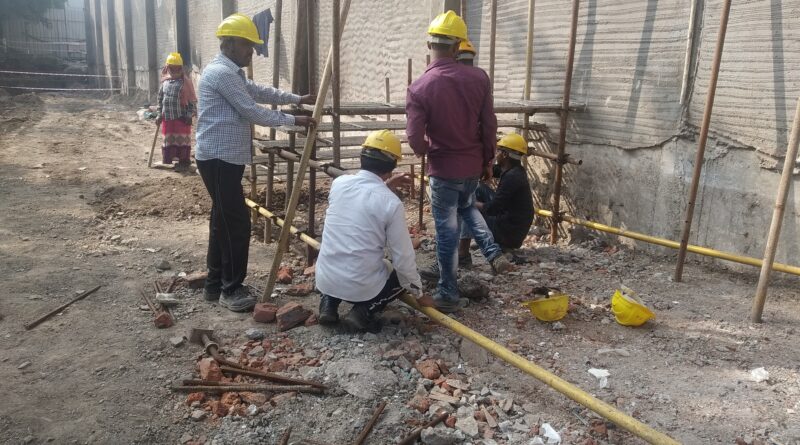Basic knowledge for civil Engineer |Every Fresher must know
DENSITY OF CONSTRUCTION MATERIALS
DENSITY OF MATERIALS. The density of an object is defined as the mass of a unit of material and is designated by the symbol ρ (rho). The SI unit of density is kg / m³ and the U.S. Typical unit of density in lb / ft³.
— Concrete: 2370 kg/m³
— Cement: 1440 kg/m³
— Cement Mortar: 2080 kg/m³
— Brick: 1600-1920 kg/m³
— Brick Masonry: 1920 kg/m³
— Cast Iron: 7208 kg/m³
— Teak Wood: 670–830 kg/m³
— Marble: 2560 kg/m³
— Limestone: 2739 kg/m³
— Granite Stone: 2460–2800 kg/m³
— Tar:1150 kg/m³
— RCC 2% Steel: 2420 kg/m³
— Aluminium: 2739 kg/m³
— Gravel with sand: 1920 kg/m³
— Crushed Stone: 1600 kg/m³
— 1/4 inch Plywood: 3.47 kg/m³
— 1/2 inch Plywood: 6.93 kg/m³
— 3/8 inch Plywood: 5.18 kg/m³
— 1/2 inch Gypsum: 7.62 kg/m³
— 3/8 inch Gypsum: 10.2 kg/m³
— 4 inches Brick w/½” mortar: 673 kg/m³
— 8-inch Concrete Block w/½” mortar: 881 kg/m³
— 12-inch Concrete Block w/½” mortar: 1281 kg/m³
— C. Sheet Corrugated: 16 kg/m³
— Porcelain: 2400 kg/m³
— Window Glass: 2580 kg/m³
— Dry Sand: 1600 kg/m³
— River Sand: 1840 kg/m³
— PCC: 2240 kg/m³
— Steel: 7849 kg/m³
(2) HOW DO YOU CALCULATE THE WEIGHT OF A STEEL BAR?
(OR)
WHAT ARE THE WEIGHTS OF 16MM, 12MM, 20MM, 25MM AND 8MM DIA STEEL BARS?
(D)2/162.5
So wight of 8 mm bar will be,
(8 x 8) / 162.5 = 0.39 kg/ meter
similarly, the weight of bars will be as follows,
12 mm = 0.89 kg/ meter
16 mm = 1.58 kg/ meter
(3) WHAT IS THE SIZE OF A STANDARD SIZE BRICK?
STANDARD BRICKS
The standard coordination size for brickwork is 225mm x 112.5mm x 75mm (length x depth x height). It has 10mm mortar joints, so the standard size for a brick is 215mm x 102.5mm x 65mm (length x depth x height)
(4) QUESTION ABOUT AAC BLOCK (AUTOCLAVED AERATED CONCRETE)
| SIZE | 24 IN. X 8 IN. X 4 IN. ( UP TO 9 IN.) |
| SHAPE | RECTANGLE |
| MATERIAL | CONCRETE |
| FOR USE IN | SIDEWALLS, PARTITION WALLS |
| COMPRESSIVE STRENGTH | 3 N/MM2 |
| BRICK/BLOCK COLOR | GREY |
| SOUND RESISTANCE | 37 – 42 DB |
| THERMAL CONDUCTIVITY | 0.122 W/MK |
| THICKNESS | 200 MM |
| DRY DENSITY | 550 – 650 KG/M3 |
| FIRE RESISTANCE | 4 – 6 HRS |
| BRICK TYPES | AUTOCLAVED AERATED CONCRETE |
| COLOUR | GRAY |
| METHOD | AUTO CLAVED |
| USAGE/APPLICATION | PARTITION WALLS |
| PRODUCT TYPE | BLOCKS |
| CAPACITY BRICKS PER HOUR | WE HAVE TWO PRODUCTION UNITS |
| FEATURES | LIGHT WEIGHT |
FEATURES:
1.Accuracy In Size: high dimension precision, available in exact sizes, no coarse setting mortar required.
2.Better Sound Insulation: Provides More Sound Insulation.
3.Energy Saving: Renacon’s low thermal conductivity guarantees better thermal energy efficiency.
4.Highly Insulating: Excellent Thermal Insulation Higher Saving On Cooling And Heating Costs.
5.High Workability: blocks can be easily cut, drilled, milled and grooved. Excellent size / weight ratio.
6.Fire Resistant: Non-combustible and can withstand up to 4-6 hours of direct heat exposure.
7. Faster Construction: Reduces construction time by 20%. Easy to install. ACC construction is very fast.
8.Low Water Absorption: the water absorption of ACC blocks is relatively low than other.
9. Longer In Size And Thinner Mortar Required: The ACC Block Are Longer In Size Compared To Its Counterpart Red Clay Bricks. ACC Blocks Also Required Lesser Mortar.
(5) HOW MUCH CONCRETE IS IN A READY-MIX TRUCK?
TRUCK CAPACITY IS 8 CUBIC YARDS (6.1 M3).
(6) WHAT IS THE STANDARD HEIGHT OF A FLOOR?
10 ft
The floor-to-floor height is generally 7.5 ft in the case of the residential building. On the other hand, the height of each story in commercial buildings is 10 ft
(7) CONCRETE MIX RATIO
| GRADES OF CONCRETE | RATIOS OF CONCRETE MIX DESIGN(CEMENT:SAND:AGGREGATE) |
| M5 | 1:5:10 |
| M7.5 | 1:4:8 |
| M10 | 1:3:6 |
| M15 | 1:2:4 |
| M20 | 1:1.5:3 |
| M25 | 1:1:2 |
| M30 | 1:0.75:1.5 |
| M35 | 1:0.5:1 |
| M40 | 1:0.25:0.5 |
(8) WHAT IS THE INITIAL AND FINAL SETTING TIME OF CEMENT MIX
600 minutes
The time at which cement completely loses its plasticity and became hard is a final setting time of cement. The time it takes the cement to reach its full strength is the final composition of the cement. For normal Portland cement, the final setup time is 600 minutes (10 hours)
Initial setting time = 30 min | Final setting time = 10 hr
(9) WHAT ARE THE CAUSES OF CRACK IN CONCRETE?
1. Loss of water from the surface of the concrete.
2. Bleeding of water from concrete.
3. Delayed curing of concrete.
4. Unsound material.
5. Shrinkage.
(10) CHECKLIST OF SLAB FORMWORK
1. The check is applied to the oil form.
2. Check that no additional oil is available within the form.
3. Check the slab size in all directions.
4. Perimeter Horizontal bracing is used on the perimeter.
5. Check that the simple sheet does not slip into the beam.
6. The check beams are straight and positioned according to the diagram.
7. Check that the nut-bolt / shutter clip is fixed or tight on each shutter hole.
8. The last dimension is the working dimension of the form according to the architectural drawing.

